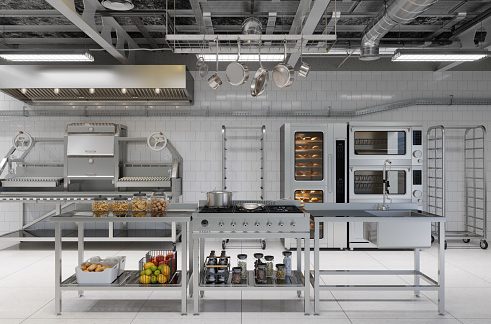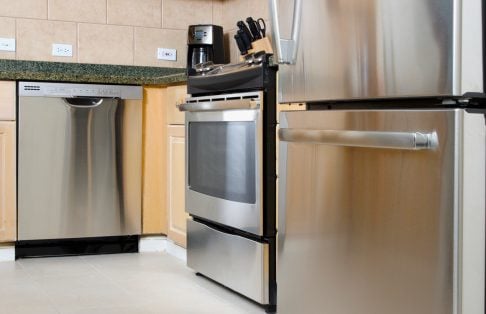BLOGS
Stainless Steel: How To Clean It
A Stainless steel is a family of alloy steels containing 10 to 30% chromium. In conjunction with its low carbon content, and of chromium oxide provides exceptional corrosion and heat resistance. Other elements, such as nickel, molybdenum, titanium, aluminum, niobium, copper, nitrogen, sulfur, phosphorus, or selenium, may be added to improve corrosion resistance, oxidation resistance, and impart special properties.
Stainless steel is a great material for kitchens and bathrooms because it is both durable and shiny. However, as anyone who has owned stainless steel kitchen appliances knows, the name is somewhat misleading. Fingerprints, streaks, and water stains are common with this material. The term “stainless” was originally applied to metals that could withstand heat and humidity without corroding. Although stainless steel is a tough material, harsh abrasives can scratch or rust it, so it’s critical to learn how to clean stainless steel properly.
Designers have frequently debated whether it will continue to reign supreme in kitchens or succumb to the allure of glossy black or white appliances with sleek, smooth finishes.
While the debate rages on, the popularity of stainless steel appliances, countertops, and other kitchen elements grows. Whether you have a few or a lot of the shiny stuff, here’s what experts recommend you do about those fingerprints, as well as how to care for and to clean your one of the surface of a house’s hardest-working.
In addition to its appealing look and smooth, impermeable surface that prevents the growth of bacteria and other microbes, it is used so frequently in commercial kitchens because it resists rusting despite normal usage and wear.

Unfortunately, this does not rule out the possibility of rust and stains. The protective film on stainless surfaces becomes vulnerable to damage if it is scratched with a steel pad or wire brush, comes into contact with hard water that is allowed to puddle or sit, or is exposed to chlorides from household cleaners, according to experts at the North American Association of Food Equipment Manufacturers.
How to Clean Stainless Steel
The distinctive gleam of stainless steel can be found everywhere, from the kitchen sink to the top of the Chrysler Building. And it’s no surprise: it’s a high-performance marvel, a material that won’t corrode or rust. It also does not stain easily, though it is not stain-proof. Because of its low maintenance and distinctive luster, it is popular in cookware, cutlery, hardware, and major appliances such as refrigerators and stovetops, as well as surgical instruments and many industrial applications.
Fortunately, it is simple to clean using a variety of low-cost methods. Unlike some materials, it thrives when cleaned frequently. A stainless steel surface cannot be worn out by excessive cleaning.
Follow the instructions below to make it shine and live up to its name.
Stainless Steel Cleaning Tip #1: Safety First
It’s a good idea to check the manufacturer’s recommendations before cleaning a stainless steel appliance. Have you misplaced your manual? Don’t be concerned; you might be able to find it online. Because there are various grades of stainless steel that may be more or less durable, and some appliances are treated with a clear-coat finish that can be stripped by certain cleaning products, it’s critical to read the instructions for your specific appliance.
To clean it, start with the right tools for safe care and cleaning. As a first line of defense, the European Stainless Steel Development Association, or ESDA, recommends using soft sponges and microfiber cloths or with a soft cloth.
Steel scouring pads, which can scratch your stainless steel steel, should not be used to clean . For tough jobs, use plastic scrubbing pads instead.
Stainless Steel Cleaning Tip #2: Go with the Grain
Stainless steel, like wood, has a grain. Examine the striations on your appliance’s surface and wipe in that direction, beginning at the top and working your way down.
Wipe and scrub your stainless steel surfaces with brushed or polished finishes in the direction of the metal’s “grain” lines.
Stainless Steel Cleaning Tip #3: Better with Age
According to the ESDA, in addition to an increasing number of fingerprint-proof finishes, regular stainless steel shows fewer fingerprints over time. Patience is a quality.

Stainless Steel Cleaning Tip #4: Stainless Solutions
The key on how to clean stainless steel appliances is consistency. Remain consistent, most cleansers do not blend well together, making it much more difficult to keep perfect. You may use CLR, a stainless steel cleaner to clean stainless steel appliances and any stainless steel surface. It will remove hard stains of water and from the water and ice dispensers, as well as any drips or food.
Because chloride-containing products can harm the protective finish of your stainless steel, the ESDA recommends using the following:
- Baking soda (to remove coffee deposits)
- Diluted vinegar (to remove and for cleaning limescale)
- Chloride-free glass sprays (especially efficient for polished, mirror-like surfaces)
- Alcoholic solvents, such as acetone (to remove adhesives)
- Commercially manufactured pastes and sprays that specify use on stainless steel
Stainless Steel Cleaning Tip #5: Naturally Clean
To clean using pantry items, damp a clean cloth or a microfiber cloth with undiluted white vinegar or olive oil and wipe it in the direction of the grain of your stainless steel.
Pouring dish soap with warm water and club soda on an absorbent cloth or a microfiber cloth to scrub, then wiping dry, is suggested for cleaning your stainless steel sink or any stainless steel surface is the most basic way to clean it.
Stainless Steel Cleaning Tip #6: Shine On
Spray cleansers designed specifically for cleaning decorative stainless steel surfaces typically contain silicone oil, and while they remove fingerprints and smudges, they do not prevent them. The silicone oil can be completely removed by washing with mild soap and warm water.
Another method to keep appliances gleaming is to use with a polishing paste. Commercially available pastes, such as 3M Marine Metal Restorer and Polish, will leave a microscopic wax layer on the surface, making cleaning easier. Because the pastes are detergent resistant, treatment with a polishing paste can last for several months. It can be removed with a soft cloth and alcohol.

Pastes and sprays designed for cleaning decorative elements — refrigerator doors, kitchen backsplashes, and other types of appliances — should not be used on pots, pans, or surfaces where food is prepared.
Silver dip polishes, such as those used to clean jewelry, are corrosive to stainless steel and should be avoided.
Brittany Corporation as the Premium Standard of High-End Residential Communities
With elegant and fashionable luxury houses, lot-only properties, and condominiums in some of the best locations in the Philippines, Brittany is the gold standard of high-end residential communities.
In some of the most exclusive neighborhoods in the Philippines, such as La Posada in Sucat, Crosswinds Tagaytay, Portofino in Alabang, Promenade, and Georgia Club in Santa Rosa, Laguna, Brittany offers a high standard of living.
Suggested Read: Mediterranean Diet 101: A Guide For The Filipino Palate
Suggested Read: 2021 Luxury Watch Brands For Men
Suggested Read: The Amazing Benefits Of Brown Rice
Suggested Read: How To Maintain Antique Furniture
Suggested Read: Ways To Care For Your Golf Clubs















